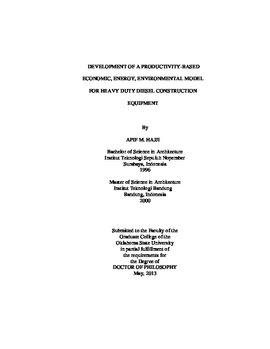| dc.description.abstract | The use of heavy duty diesel (HDD) equipment in infrastructure projects accounts for a large quantity of fuel consumption, pollutants emissions and the majority of the total cost of the project compared to others. Construction professionals need a tool that can be used to estimate not only the cost, but also the fuel use and emissions footprint of construction projects, particularly HDD equipment activities. The main purpose of this research is to develop an E3 tool to estimate the economic, energy, and environmental impact of bulldozers, scrapers, excavators, and dum trucks. The tool was developed by combining the multiple linear regression (MLR)-based productivity rate model of selected HDD equipment from RSMeans Heavy Construction Data with the US EPA's NONROAD model. The results showed that the overall productivity prediction models accounted for high percentage of variability in its respective data source; 95% for bulldozer, 99% for scraper, 92% for excavator, and 94% for dump truck. While the cost models also accounted for high percentage of variability, which are 97% for bulldozer, 99% for scraper, 70% for excavator, and 88% for dump truck. Since the productivity and cost models had high precision and accuracy with low bias, it can be used as the basis for estimating the total cost and fuel quantities that will be required and the total expected pollutant emissions for the project. The total fuel use and emissions estimates resulted from E3 model are also useful to observe its relationship with HDD equipment performance attributes, such as engine size and the attachments set up to the equipment (buckets or blades), and with various earthwork working conditions, such as type of soil, distance, depth, and cycle time. This tool can also be used to estimate emissions for various construction sectors. By using construction plans and specifications, the methodology and tool presented in this research can be used to estimate cost, fuel use, and emissions from commercial, residential, industrial, or heavy highway. Once all types of construction can be covered by this methodology, it is possible to develop new fuel use and emissions inventories for the construction industry in general. | |
